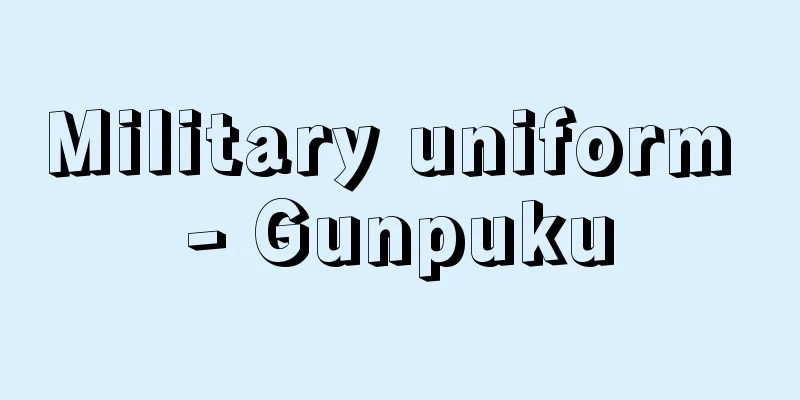Military uniform - Gunpuku

|
Uniforms worn by regular soldiers. Coats, raincoats, hats, and shoes can also be considered military uniforms in a broad sense. They are intended to distinguish between friend and foe and non-combatants, and to symbolize military unity, and emphasize interchangeability, functionality, and durability. They are classified according to the army, navy, and air force, rank (such as officers or soldiers), branch (such as infantry, cavalry, artillery, and engineering), season (summer, winter, or winter), region (such as cold or tropical), work (such as regular or special duties), gender, and age. In the past, the same uniform was used for both everyday and combat, but modern regular armies have come to distinguish between ceremonial (formal attire), everyday (military uniform), and combat (casual attire) worn during training, exercises, and combat. [Terada Chikao] historyClothing similar to military uniforms has existed since the emergence of armies, and there are many records of rulers of various tribes and tribes providing the same uniforms to their soldiers to demonstrate unity, which can be found in the birthplaces of civilization, such as Greece, Rome, Egypt, Mesopotamia, and China. However, this was limited to low-ranking soldiers and mercenaries, while leaders, nobles, and captains wore whatever they wanted at their own expense. In addition, military uniforms differed depending on the tribe, and there was far from being a unified military. Rather, uniformity was sought in the soldiers' weapons and armor, which became the uniform. The conventional theory is that military uniforms originated from the historical fact that both sides fought in the Wars of the Roses (1455-85) to succeed the English throne wearing red and white rose insignias. In 1644, Cromwell of England made the Parliamentary New Model Army wear red uniforms, and in 1670, Louis XIV adopted a uniform military uniform for all troops (with differences depending on the branch of the military) at the expense of the state, and from the 17th to the 18th centuries, national armies in various European countries began to wear uniforms. All of these uniforms were ornate designs with elaborate gold and silver decorations on bright primary colors such as red, blue, yellow and green, and like Japan's armor, they made warriors the flower of men, and the fashion of the lancers and dragoons of the Napoleonic Wars is a prime example of this. In the second half of the 19th century, with the rapid development of firearms, conspicuous primary colored uniforms came to be avoided as they were disadvantageous in field battles. During the South African War (Boer War), British troops dispatched from India achieved camouflage by wearing khaki (meaning dust in Hindi) colored uniforms, so other countries' armies followed suit and began to adopt uniforms in blending colors such as dark green, gray-green, yellow-brown, and brown to suit the country's terrain. On the other hand, in the navy, each country added functionality to the basic black or navy blue (white for summer uniforms), and officers changed to frock coats, stand-up collars, and suits, while soldiers traditionally wore what is commonly called sailor suits. Also, the uniforms of the air force, which was established in the 20th century, were initially the same as those of the army, but eventually settled on sky blue suits. In Japan, uniforms for the Army, Navy and Marines were established when the national military was unified in 1870 (Meiji 3). The Army modelled itself on France, while the Navy modelled on Britain, with designs used to distinguish between officers and soldiers. Ranks and branches of the military were indicated by rank insignia and branch insignia. In the latter half of the Russo-Japanese War, the traditional navy blue fabric changed to brown, and in the Showa period, the stand-up collar was replaced by a turn-down collar under German influence. The Army's everyday and combat uniforms were the same type, with various types of special clothing, including cold weather clothing, heat weather clothing, aviation suits, tank suits and gas-resistant suits. The Navy has not undergone any major changes since its establishment, and in the latter stages of World War II, green land combat uniforms were adopted, which were also worn by naval crew members. [Terada Chikao] "Japanese Military Uniforms" by Yoshihiko Sasama (1970, Yuzankaku Publishing) "History of Modern Japanese Military Uniforms" by Rin'ichiro Ota (1972, Yuzankaku Publishing) "Military Uniforms of the World" by Tadanao Saito and Kazuo Hozumi (1971, Fujingahosha) Following the Tokugawa Shogunate, the army's uniforms were heavily influenced by the French army, and this remained as formal attire for a long time. Eventually, it was replaced by the Prussian/German style, the victor of the Franco-Prussian War, and after several wars, a uniquely Japanese fashion was established. Shown here are representative military uniforms from the Second Sino-Japanese War to the Pacific War (1937-1945), and there were also special uniforms for airmen, tank crew, naval crew, etc. Army uniforms were uniformly khaki and practical, and in some ways lacked smartness. (1) Full uniform of an army general (tai-fuku) consisting of a full cap, full hakama, sash, sash, full sword belt, full epaulettes, and full shoes. (2) Military uniform of an officer wearing an iron cap. (3) Staff officer wearing a staff sash. (4) Non-commissioned officer with a sword hanging down. (5) Soldier holding a rifle. (6) Full uniform of a soldier seen from behind. (7) Full uniform of a lieutenant in the Imperial Cavalry. (8) Military police wearing armbands. (9) Soldier wearing cold weather gear. (10) Non-commissioned officer wearing summer clothing for the southern front. ©Masazumi Fujita "> Japanese Army uniforms From the Meiji era until the end of the Pacific War, the Navy's military uniforms traditionally followed the British (and partly American) style, some of which are still used by the current Japan Maritime Self-Defense Force. The basic colors were navy blue in winter and white in summer, but as the scope of land-based duties expanded, greenish-brown land combat uniforms appeared, and by the end of the war, most were wearing Type 3 uniforms. In addition, there were special-duty uniforms for airmen, maintenance soldiers, and kamikaze boat crew, and military uniforms suited to the location of duty, such as cold weather clothing and heat weather clothing. (1) Admiral's uniform The Navy has two types of formal uniform: a tailcoat and a frock coat, and is ornately decorated with a distinctive formal hat, gold epaulettes, a formal sword, and a sword belt. (2) Officers in first-class uniform (autumn, winter) (3) Officers wearing overcoats (4) Officers in second-class uniform (summer) (5) NCOs in first-class uniform (6) Soldiers in first-class uniform (7) Soldiers in second-class uniform (8) Soldiers in business uniform (work clothes) (9) Staff officers in third-class uniform (land warfare) (10) Full uniform of Marine Corps soldiers © Masazumi Fujita "> Japanese Navy uniforms Source: Shogakukan Encyclopedia Nipponica About Encyclopedia Nipponica Information | Legend |
|
正規軍人の着用する制服。外套(がいとう)、雨着、帽子、靴なども広義の軍服といえる。敵味方や非戦闘員との識別、軍隊団結の象徴などを目的とし、共通互換性、機能性、耐久性を重視する。 陸・海・空の各軍、将校・兵士などの階級身分、歩・騎・砲・工などの兵科、夏・冬・合(あい)の季節、寒帯・熱帯などの地域、通常勤務・特殊勤務などの作業、男女の性別、年齢などによってそれぞれ区分される。古くは日常用、戦闘用とも同一のものを用いたが、近代正規軍では儀礼用(正装)、日常用(軍装)、訓練・演習・戦闘に着用する戦闘用(略装)と区別するようになった。 [寺田近雄] 歴史軍服に類する衣服は、軍隊の発生とともにあり、各種族、部族の支配者が自分の手兵に同一の服を支給し団結を誇示した記録は、ギリシア、ローマ、エジプト、メソポタミア、中国など文明発祥地に多くみられる。ただしこの場合は下級兵士や傭兵(ようへい)に限られ、指導者、貴族、隊長クラスは自弁の自由な服装である。また部族が異なると軍服も異なって、全軍的統一にはほど遠く、むしろ統一性は兵士たちの武具甲冑(かっちゅう)に求められ、それがユニホームとなっていた。 定説では、イギリスの王位継承戦「ばら戦争」(1455~85)で両軍がそれぞれ赤ばら、白ばらの記章をつけて戦った史実を軍服の発祥としている。1644年、イギリスのクロムウェルが議会派新模範軍に赤服を着用させ、また1670年、ルイ14世が国費をもって全軍統一の軍服(兵科による差はあり)を採用するなど、17世紀から18世紀にかけてヨーロッパ各国の国民軍は制服を着用するようになった。これらはいずれも赤青黄緑などのはでな原色地に金銀の装飾を凝らした華美なデザインで、わが国の鎧兜(よろいかぶと)と同じく武人を男子の華とするもので、ナポレオン戦争の槍騎兵(そうきへい)、竜騎兵のファッションはその代表例である。 19世紀後半に入ると火器の急激な発達により、目だつ原色軍服は野戦に不利なため避けるようになった。南ア戦争(ブーア戦争)の際、インドから派遣されたイギリス軍がカーキkhaki(ヒンディー語で土ぼこりの意)色の軍服で迷彩効果をあげたので各国軍はこれに倣い、いずれも国土にあわせて濃緑、灰緑、黄褐、褐色などのじみな色の軍服を採用するようになった。 一方、海軍では、各国とも黒または紺色(夏服は白)を基礎に機能性を加味し、幹部はフロックコート、詰襟、背広型に変わり、兵士は俗にセーラー服とよばれる型に伝統化された。また20世紀に創設された空軍の制服は初めは陸軍と同じで、やがて空色背広型に定着した。 日本では1870年(明治3)国軍の統一とともに陸、海、海兵の服制を定め、陸軍はフランス、海軍はイギリスを模範として、将校と兵士をデザインで区別。階級、兵科は階級章、兵科章で表した。日露戦争後半から従来紺系統の布地が茶褐色となり、昭和に入ってドイツの影響で詰襟から折襟となった。陸軍は日常衣と戦闘衣は同型で、特殊被服として防寒衣、防暑衣、航空服、戦車服、防毒服など各種があった。海軍は建軍以来大きな変革はなく、第二次世界大戦後期に緑色の陸戦服が採用され、艦艇乗員もこれを着用した。 [寺田近雄] 『笹間良彦著『日本の軍装』(1970・雄山閣出版)』▽『太田臨一郎著『日本近代軍服史』(1972・雄山閣出版)』▽『斎藤忠直・穂積和夫著『世界の軍服』(1971・婦人画報社)』 陸軍は徳川幕府に続いて軍服にもフランス陸軍の影響を強く受け、それは長く礼装に名残をとどめた。やがて普仏戦争の勝者、プロイセン・ドイツ式に変わり、数次の戦争を経て日本独自のファッションが確立した。ここに掲げたものは日中戦争から太平洋戦争(1937~1945)に至る代表的な軍服で、ほかに航空兵、戦車兵、船舶兵などの特殊被服がある。陸軍の軍服は一様にカーキ色で実質本位であったため、スマートさに欠ける面もあった。(1)陸軍大将の正装 (大礼服)正帽、正衣袴、飾帯、飾緒、正刀帯、正肩章、正靴よりなる (2)鉄帽をかぶった将校の軍装 (3)参謀飾緒をつけた参謀 (4)軍刀を下げた下士官 (5)執銃の兵 (6)後ろから見た兵の完全軍装 (7)近衛騎兵少尉の正装 (8)腕章をつけた憲兵 (9)防寒装備の兵 (10)南方用防暑衣の下士官©藤田正純"> 日本陸軍の軍服 海軍の軍服は明治以来太平洋戦争終戦まで、手本としたイギリス(一部アメリカ)のモードを伝統的に守り続け、その一部は現在の海上自衛隊に受け継がれている。冬は紺地、夏は白地が基調であるが、やがて陸上勤務の範囲が広がるにしたがって緑褐色の陸戦服が登場し、戦争末期には大部分が三種軍装姿となった。このほかにも航空兵、整備兵、特攻艇兵などの特殊勤務用被服があり、防寒服、防暑服など勤務地にあわせた軍服があった。(1)海軍大将の正装 海軍には燕尾服の正装とフロックコートの礼装の2種があり、特色ある正帽、金色の正肩章、正剣、剣帯で華麗に彩られる (2)一種軍装(秋、冬)の士官 (3)外套着用の士官 (4)二種軍装(夏)の士官 (5)一種軍装の下士官 (6)一種軍装の兵 (7)二種軍装の兵 (8)事業衣(作業着)の兵 (9)三種軍装(陸戦用)の参謀 (10)陸戦隊の兵の完全軍装©藤田正純"> 日本海軍の軍服 出典 小学館 日本大百科全書(ニッポニカ)日本大百科全書(ニッポニカ)について 情報 | 凡例 |
<<: Kumbum Temple - Kumbumji (English name) Sku 'bum
Recommend
Katsura Taro
A Meiji era soldier and politician. Born November...
DDT - DDT
Abbreviation for dichlorodiphenyltrichloroethane....
《Vaiṣesika-sūtra》(English spelling)
He is believed to have lived between 150 and 50 B...
Sonic prospecting - Onpatansa (English spelling)
Seismic waves are used to investigate the geologic...
River body - Kashin
〘 noun 〙 The part of the river where the water flo...
Pipridae
...A general term for birds of the family Piprida...
revenue tariff
A tariff is a tax imposed primarily for the purpo...
Casaba Lupin - Casaba Lupin
...also known as narrow lupine), white lupine L. ...
Entract - Entract
…(3) Interlude music, usually instrumental, playe...
Aikyoukai - Aikyoukai
…Formally known as the Aikyo Juku, a self-run rur...
Khwarizm (English spelling)
…The name refers to the area of the lower Amu D...
Ranch - Bokujo
A ranch is a place with pastures, barns, and othe...
The Prince - Il Principe
A representative work by Italian Renaissance poli...
Suggestion - Anji
When a person (the suggester) conveys feelings, i...
Ishige Tsumugi
…The central settlement of Ishige flourished in t...









